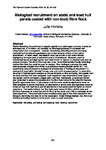Biological recruitment on static and boat hull panels coated with non-toxic fibre flock
| dc.contributor.author | Hinrichs, J. | |
| dc.date.accessioned | 2022-12-23T19:40:49Z | |
| dc.date.available | 2022-12-23T19:40:49Z | |
| dc.date.issued | 2022 | |
| dc.identifier.citation |
Hinrichs, J. (2022) 'Biological recruitment on static and boat hull panels coated with non-toxic fibre flock', The Plymouth Student Scientist, 15(2), pp. 221-238. | en_US |
| dc.identifier.issn | 1754-2383 | |
| dc.identifier.uri | http://hdl.handle.net/10026.1/20116 | |
| dc.description.abstract |
Marine biofouling, the settlement of aquatic organisms on submerged surfaces, creates an estimated cost of 20 billion USD annually for the shipping industry in increased fuel consumption due to overgrowth. However, the existing antifouling solutions are being restricted by international organisations due to their adverse effects on the marine environment. In recent years, the research focus has shifted to non-toxic methods highlighting the importance of settlement cues of invertebrates. Biofoulers, such as invertebrate larvae and algal spores have been shown to respond to physical cues such as surface structure. The aim of this study was to test the environmentally friendly antifouling method fibre flock that could be used for vessels. Fibre flocking is a process that adds electrostatically charged micro-fibres to an adhesive coated polyester carrier film. Two experiments were conducted to evaluate the effectiveness of flocking on recruitment: (1) dock and (2) boat hull in Arendal, Norway, over a 3-month exposure period. To determine the effect of hydrodynamic pressure on the performance of fibre antifouling, fibre panels from the dock and boat hull were compared. Each experiment was comprised of three types of test panels: control (untreated), copper paint, and fibre. Additionally, a systematic review was conducted to assess the prevalence of the fibre flock method in the scientific literature. Specific hypotheses were: (1) abundance of all live cover would be significantly lower on fibre compared to control treatments; (2) abundance of all live cover and barnacles would be lowest on boat hull treatments; and (3) abundance of barnacles would be higher on control treatments. The results indicate that fibre flock could reduce 81.6% of all live cover and 84.4% of barnacles on a boat hull and 28.2% of all live cover, and 1.8% of barnacles on the dock experiment. The systematic review revealed a clear gap of fibre flock research in the literature, identifying the need for further exploration. These findings highlight that fibre is an effective antifouling method to some extent, even for static structures. | en_US |
| dc.language.iso | en | en_US |
| dc.publisher | University of Plymouth | en_US |
| dc.rights | Attribution 3.0 United States | * |
| dc.rights.uri | http://creativecommons.org/licenses/by/3.0/us/ | * |
| dc.subject | Biofouling | en_US |
| dc.subject | antifouling | en_US |
| dc.subject | self-cleaning | en_US |
| dc.subject | fibre | en_US |
| dc.subject | flocking | en_US |
| dc.subject | recruitment | en_US |
| dc.title | Biological recruitment on static and boat hull panels coated with non-toxic fibre flock | en_US |
| dc.type | Article | en_US |
| plymouth.issue | 2 | |
| plymouth.volume | 15 |



